I was first introduced to Biscoff cookies on a flight to London. My youngest, curled up beside me, had refused every snack I packed, but lit up when the flight attendant handed her a tiny red-wrapped cookie. She took one bite, paused, and whispered, “It tastes like Christmas.” I smiled, took mine, and agreed. It was spiced, caramelized, cozy—all the things a good moment should be.
Years later, after a particularly long day in the kitchen, I found myself scooping cookie butter straight from the jar. It hit me—what if this flavor could be turned into a cake? Not just any cake. One that was soft, warm, and carried every note of that little Biscoff cookie—cinnamon, brown sugar, and just enough toastiness to feel like a hug.
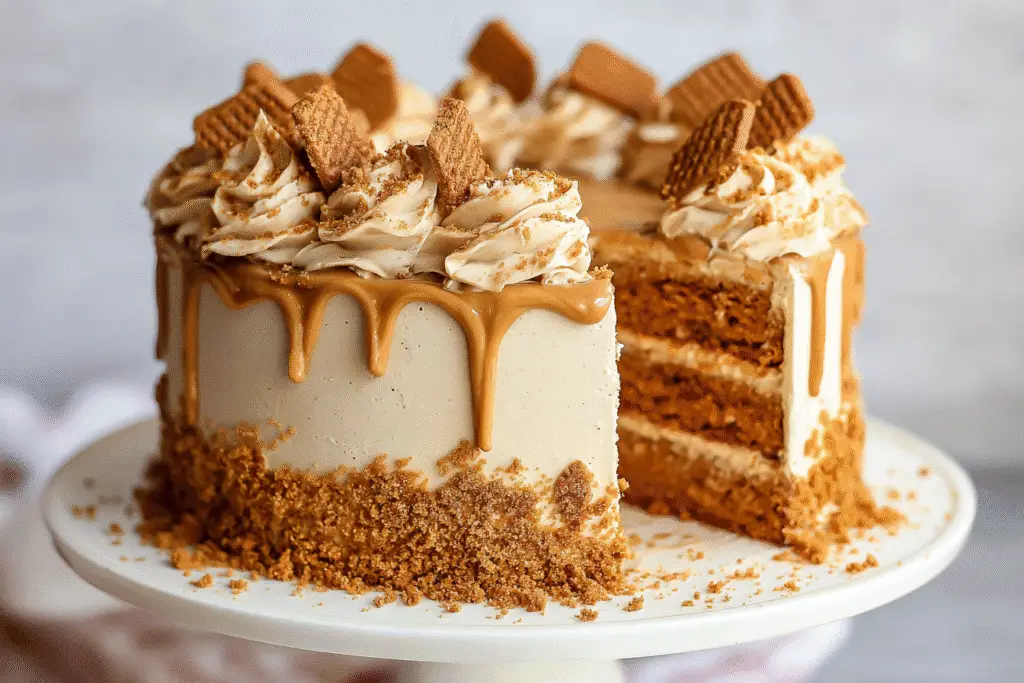
This Biscoff Cookie Butter Cake was born from that craving. Moist, layered, unapologetically rich, and covered in a Biscoff buttercream that melts like velvet. It’s indulgent but balanced. Familiar, but unforgettable.
What is Biscoff Cookie Butter Cake?
A Biscoff Cookie Butter Cake takes everything people love about Biscoff cookies—warm spice, deep caramel flavor, and that unmistakable crunch—and transforms it into a layered dessert worth celebrating.
- The sponge is soft and brown sugar–based, sometimes with crushed Biscoff cookies folded in.
- The buttercream includes smooth Biscoff cookie butter for intense flavor and creamy texture.
- Topped with a drizzle of melted cookie butter or crumbled cookies for that signature crunch.
It’s not overly sweet. It’s not just another trend. It’s comfort, elevated with intention.
Why You’ll Love This Biscoff Cookie Butter Cake
- Packed with real cookie butter in both cake and frosting
- Naturally pork-free and alcohol-free
- Layers hold together beautifully without crumbling
- Tastes like spiced brown sugar shortbread in cake form
- Pairs perfectly with tea, coffee, or even oat milk lattes
Tips for Making the Best Biscoff Cookie Butter Cake
- Use creamy Biscoff spread, not chunky. It blends seamlessly into both cake batter and frosting.
- Bring all ingredients to room temperature. Cold eggs or butter can break your batter or curdle your buttercream.
- Don’t overmix the batter. Once you add the dry ingredients, mix just until combined to avoid a dense texture.
- Crush cookies by hand. A food processor creates powder; hand-crushing gives you those crave-worthy crunchy bits.
- Cool cake layers completely. Warm cake will melt the frosting and ruin the structure.
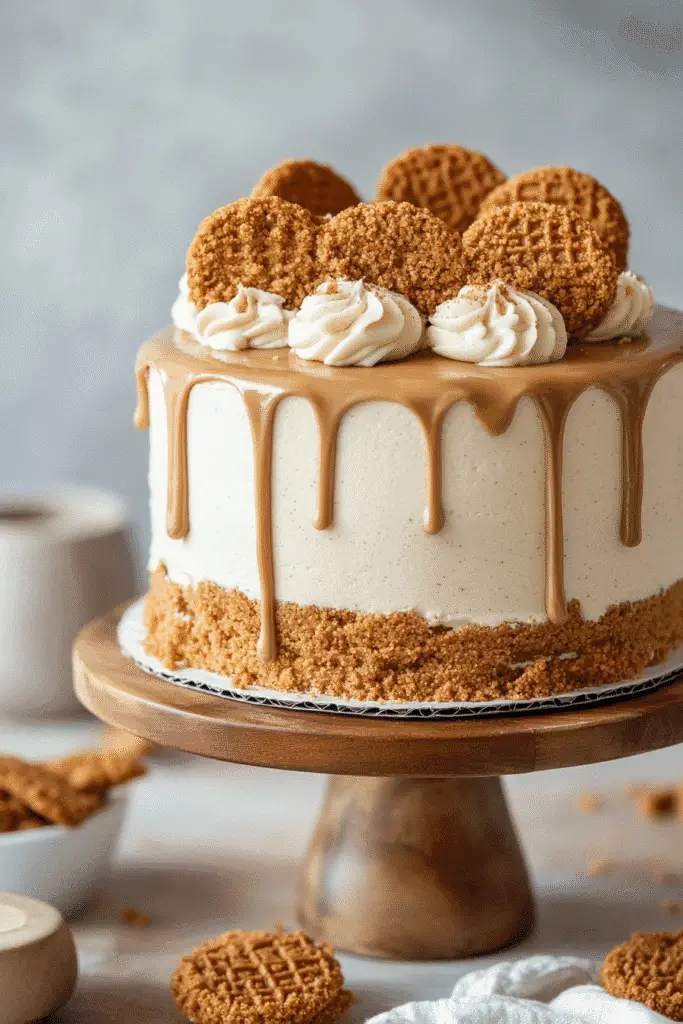
Tools You’ll Need
- 3 (6-inch or 8-inch) round cake pans
- Electric mixer or stand mixer
- Offset spatula
- Parchment paper
- Cooling rack
- Mixing bowls (at least 2 large, 1 medium)
- Food scale (optional but recommended)
- Rubber spatula
Ingredients
For the Cake:
- 1 cup unsalted butter, room temperature
- 1 ¼ cups brown sugar
- ½ cup granulated sugar
- 4 large eggs, room temperature
- 1 teaspoon vanilla extract
- ½ cup creamy Biscoff cookie butter
- 2 ½ cups all-purpose flour
- 2 teaspoons baking powder
- ½ teaspoon baking soda
- ½ teaspoon salt
- 1 teaspoon ground cinnamon
- 1 cup whole milk, room temperature
- 1 cup crushed Biscoff cookies (optional)
For the Biscoff Buttercream:
- 1 ½ cups unsalted butter, softened
- ½ cup creamy Biscoff cookie butter
- 4 cups powdered sugar
- 2 tablespoons heavy cream
- 1 teaspoon vanilla extract
- Pinch of salt
Optional Toppings:
- ¼ cup melted cookie butter (for drip or swirl)
- Crushed Biscoff cookies for garnish
Step-by-Step Instructions
- Preheat your oven to 350°F (175°C). Grease and line your cake pans with parchment circles.
- Cream butter and sugars in a mixer on medium speed until fluffy, about 3–4 minutes.
- Add eggs one at a time, mixing well after each. Add vanilla and cookie butter. Beat until smooth.
- In a separate bowl, whisk together flour, baking powder, baking soda, cinnamon, and salt.
- Add dry ingredients to wet in three parts, alternating with the milk. Mix just until combined. Fold in crushed cookies if using.
- Divide batter evenly between the prepared pans. Smooth the tops.
- Bake for 28–30 minutes or until a toothpick inserted in the center comes out clean.
- Cool in pans for 10 minutes, then turn out onto wire racks to cool completely.
You Must Know
- Cookie butter is not frosting. You’ll need to whip it into buttercream to create that signature texture.
- A thin layer of cookie crumbs between cake layers adds texture without overwhelming the softness.
- This cake improves after resting overnight—flavors deepen and meld beautifully.
Top Tips for Perfecting Your Biscoff Cookie Butter Cake
- Use a cake turntable to make frosting easier and cleaner.
- Chill your cake layers before frosting for sharp edges.
- Want extra depth? Brown the butter before using it in the cake.
- Use a bench scraper to smooth out the sides of the cake like a pro.
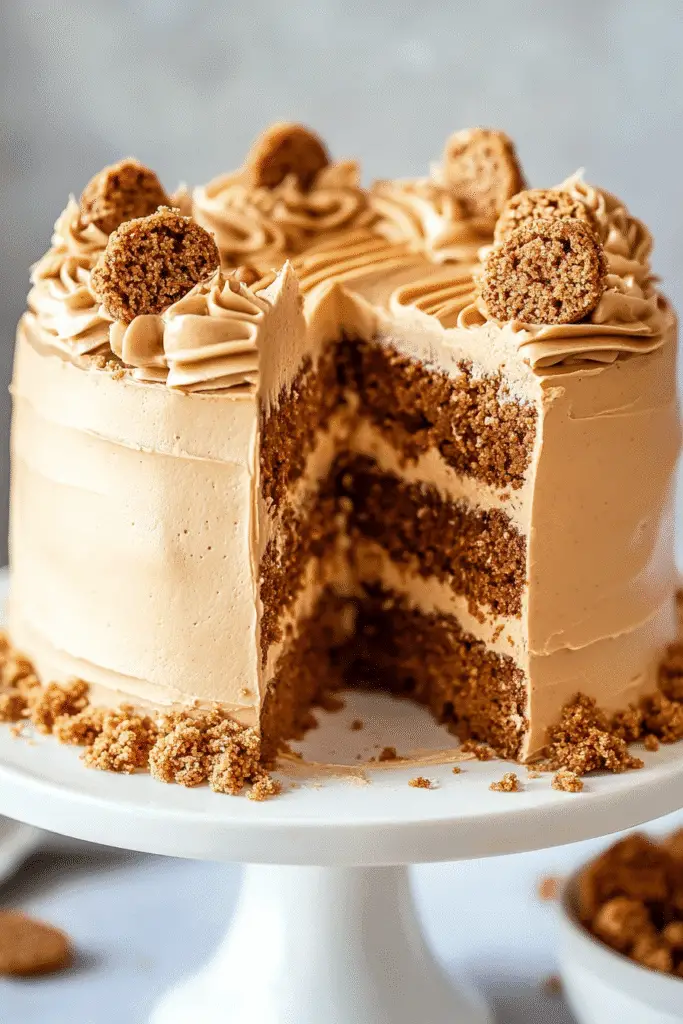
Storing and Reheating Tips
- Room Temperature: Store tightly covered for up to 2 days in a cool place.
- Refrigerator: Store in an airtight container for up to 5 days. Let slices sit out for 30 minutes before serving.
- Freezer: Wrap slices individually and freeze up to 2 months. Thaw overnight in the fridge, then let them reach room temp before serving.
This cake holds moisture well—no dry leftovers here.
Helpful Notes
- If your cookie butter is firm, microwave it for 10 seconds before mixing.
- For dairy-free versions, substitute the milk with oat milk and use a plant-based butter.
- If your frosting feels too stiff, add an extra tablespoon of cream.
Tips from Well-Known Chefs
- Christina Tosi recommends layering textures—add a cookie crumb between layers for a Milk Bar–style crunch.
- Ina Garten swears by room temperature eggs for even rise and better structure.
- Duff Goldman suggests a thin crumb coat before final frosting to keep it clean and professional.
Common Mistakes to Avoid
- Skipping the cookie butter in the frosting. That’s where the magic happens.
- Overmixing the batter. It will make the cake dense.
- Adding hot cake to frosting. It melts, slides, and breaks your final presentation.
- Using chunky cookie butter. It will clog your piping tips and mess with texture.
FAQs
Can you add Biscoff to buttercream?
Yes, and it’s the star of the show. It gives the buttercream a silky texture and that unmistakable caramel-spiced flavor. Blend it well with softened butter and powdered sugar.
What does Biscoff cake taste like?
It tastes like brown sugar, cinnamon, and caramel—all in a soft, buttery cake. Some say it reminds them of gingerbread without the bite. It’s sweet but balanced.
What is the flavor of Biscoff cookie butter?
It has deep caramel tones with warm spice, thanks to cinnamon and hints of clove. Think of a toasted graham cracker blended with butterscotch.
What is so special about Biscoff cookies?
They’re crisp, spiced, and deeply caramelized—made without nuts or chocolate, yet still rich. They hold up beautifully in desserts without getting soggy.
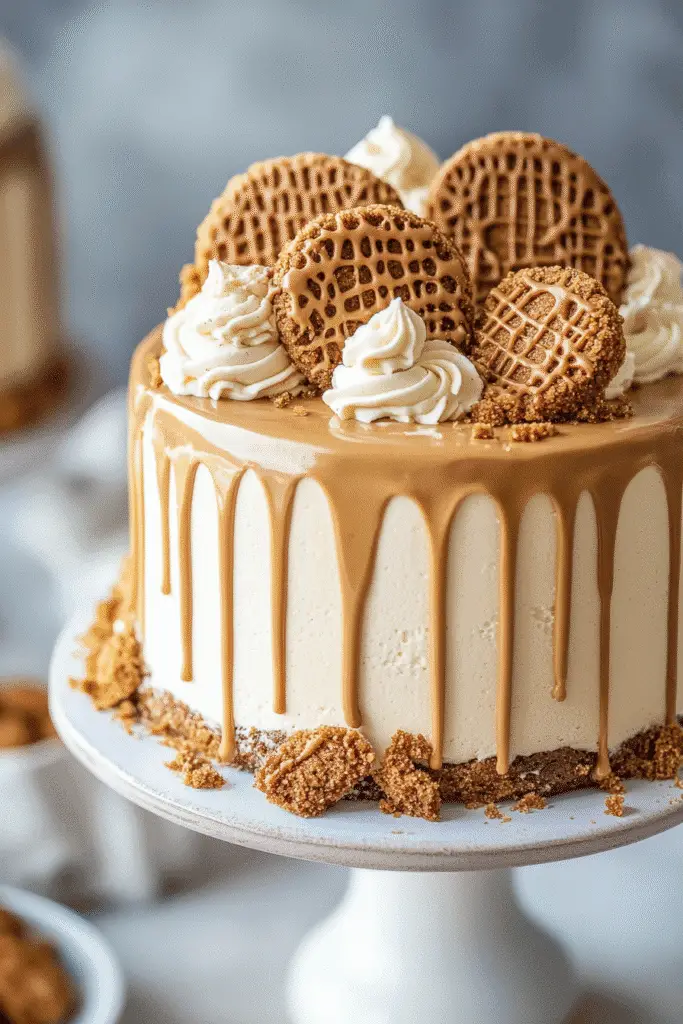
Conclusion
This Biscoff Cookie Butter Cake isn’t just another layered dessert. It’s a story. A flavor memory wrapped in brown sugar and cinnamon. Whether you serve it at birthdays, brunches, or just because your week needs something warm and sweet, it always hits the mark.
It reminds us that simple things—like a little red-wrapped cookie on a long flight—can turn into moments worth baking.
Print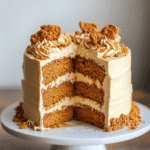
Biscoff Cookie Butter Cake
- Total Time: 1 hour
- Yield: 8 slices 1x
- Diet: Vegetarian
Description
A moist brown sugar cake infused with Biscoff cookie butter and topped with silky cookie butter frosting. Full of caramel, spice, and comfort.
Ingredients
- 1 cup unsalted butter, room temp
- 1 ¼ cups brown sugar
- ½ cup granulated sugar
- 4 eggs
- 1 tsp vanilla extract
- ½ cup creamy Biscoff spread
- 2 ½ cups all-purpose flour
- 2 tsp baking powder
- ½ tsp baking soda
- ½ tsp salt
- 1 tsp cinnamon
- 1 cup whole milk
- 1 cup crushed Biscoff cookies (optional)
- Buttercream: 1 ½ cups butter, ½ cup Biscoff spread, 4 cups powdered sugar, 2 tbsp cream, 1 tsp vanilla, pinch of salt
Instructions
- Preheat oven to 350°F. Grease and line pans.
- Cream butter and sugars until fluffy.
- Add eggs, vanilla, and cookie butter. Mix well.
- Whisk dry ingredients in a separate bowl.
- Add dry mix alternately with milk. Fold in crushed cookies.
- Divide into pans and bake 28–30 min.
- Cool completely on wire racks.
- Make frosting: Beat butter and cookie butter until smooth. Add powdered sugar, cream, vanilla, and salt.
- Frost cooled cake. Garnish with melted Biscoff or crushed cookies.
Notes
Store at room temp for 2 days or refrigerate for up to 5. Freezes well. Let come to room temperature before serving.
- Prep Time: 30 minutes
- Cook Time: 30 minutes
- Category: Cake
- Method: Baking
- Cuisine: American
Nutrition
- Serving Size: 1 slice
- Calories: 520
- Sugar: 45g
- Sodium: 190mg
- Fat: 26g
- Saturated Fat: 15g
- Unsaturated Fat: 8g
- Trans Fat: 0g
- Carbohydrates: 65g
- Fiber: 1g
- Protein: 6g
- Cholesterol: 105mg
Keywords: Biscoff Cake, Cookie Butter Cake, Biscoff Buttercream Cake